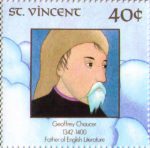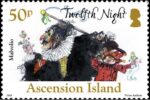🇺🇸 (The American Revolution began 250 years ago this week, on the 19th of April in 1775. We’ll have an assortment of special Revolutionary posts going up for the occasion — watch for them to appear on the River Houses website. The anniversary years 2025–2026 will present many exceptional opportunities to teach American history in your homeschool. Why not begin by turning to pages 298–299 in your recommended history encyclopedia, and then make a visit to your local library to find some books for your students about Lexington, Concord, and Paul Revere. If it’s a Dewey library, try the call number 973.3 in the Historical 900s.)
This is a special American Revolution week in the River Houses, and that means we have an extra homeschool poem-of-the-week! Yesterday we read Ralph Waldo Emerson’s “Concord Hymn,” and today we have “Paul Revere’s Ride” by Henry Wadsworth Longfellow. These have been two of the most popular American poems for generations, and every smart homeschooler should know them.
“Paul Revere’s Ride” (also known as “The Midnight Ride of Paul Revere”) is a poem about the night before the 19th of April. Here’s one of many fine dramatic readings available online for you to enjoy.
And here is the text with its galloping gait, addressed directly to your students: Listen, my children, and you shall hear.
Paul Revere’s Ride 🏇
Listen, my children, and you shall hear
Of the midnight ride of Paul Revere,
On the eighteenth of April, in Seventy-five;
Hardly a man is now alive
Who remembers that famous day and year.He said to his friend, “If the British march
By land or sea from the town to-night,
Hang a lantern aloft in the belfry arch
Of the North Church tower as a signal light, —
One, if by land, and two, if by sea;
And I on the opposite shore will be,
Ready to ride and spread the alarm
Through every Middlesex village and farm,
For the country folk to be up and to arm.”
Then he said, “Good night!” and with muffled oar
Silently rowed to the Charlestown shore,
Just as the moon rose over the bay,
Where swinging wide at her moorings lay
The Somerset, British man-of-war;
A phantom ship, with each mast and spar
Across the moon like a prison bar,
And a huge black hulk, that was magnified
By its own reflection in the tide.Meanwhile, his friend, through alley and street,
Wanders and watches with eager ears,
Till in the silence around him he hears
The muster of men at the barrack door,
The sound of arms, and the tramp of feet,
And the measured tread of the grenadiers,
Marching down to their boats on the shore.Then he climbed the tower of the Old North Church,
By the wooden stairs, with stealthy tread,
To the belfry-chamber overhead,
And startled the pigeons from their perch
On the sombre rafters, that round him made
Masses and moving shapes of shade, —
By the trembling ladder, steep and tall,
To the highest window in the wall,
Where he paused to listen and look down
A moment on the roofs of the town,
And the moonlight flowing over all.
Beneath, in the churchyard, lay the dead,
In their night-encampment on the hill,
Wrapped in silence so deep and still
That he could hear, like a sentinel’s tread,
The watchful night-wind, as it went
Creeping along from tent to tent,
And seeming to whisper, “All is well!”
A moment only he feels the spell
Of the place and the hour, and the secret dread
Of the lonely belfry and the dead;
For suddenly all his thoughts are bent
On a shadowy something far away,
Where the river widens to meet the bay, —
A line of black that bends and floats
On the rising tide, like a bridge of boats.Meanwhile, impatient to mount and ride,
Booted and spurred, with a heavy stride
On the opposite shore walked Paul Revere.
Now he patted his horse’s side,
Now gazed at the landscape far and near,
Then, impetuous, stamped the earth,
And turned and tightened his saddle girth;
But mostly he watched with eager search
The belfry-tower of the Old North Church,
As it rose above the graves on the hill,
Lonely and spectral and sombre and still.
And lo! as he looks, on the belfry’s height
A glimmer, and then a gleam of light!
He springs to the saddle, the bridle he turns,
But lingers and gazes, till full on his sight
A second lamp in the belfry burns!
A hurry of hoofs in a village street,
A shape in the moonlight, a bulk in the dark,
And beneath, from the pebbles, in passing, a spark
Struck out by a steed flying fearless and fleet:
That was all! And yet, through the gloom and the light,
The fate of a nation was riding that night;
And the spark struck out by that steed, in his flight,
Kindled the land into flame with its heat.
He has left the village and mounted the steep,
And beneath him, tranquil and broad and deep,
Is the Mystic, meeting the ocean tides;
And under the alders, that skirt its edge,
Now soft on the sand, now loud on the ledge,
Is heard the tramp of his steed as he rides.It was twelve by the village clock,
When he crossed the bridge into Medford town.
He heard the crowing of the cock,
And the barking of the farmer’s dog,
And felt the damp of the river fog,
That rises after the sun goes down.It was one by the village clock,
When he galloped into Lexington.
He saw the gilded weathercock
Swim in the moonlight as he passed,
And the meeting-house windows, blank and bare,
Gaze at him with a spectral glare,
As if they already stood aghast
At the bloody work they would look upon.It was two by the village clock,
When he came to the bridge in Concord town.
He heard the bleating of the flock,
And the twitter of birds among the trees,
And felt the breath of the morning breeze
Blowing over the meadows brown.
And one was safe and asleep in his bed
Who at the bridge would be first to fall,
Who that day would be lying dead,
Pierced by a British musket-ball.You know the rest. In the books you have read,
How the British Regulars fired and fled, —
How the farmers gave them ball for ball,
From behind each fence and farm-yard wall,
Chasing the red-coats down the lane,
Then crossing the fields to emerge again
Under the trees at the turn of the road,
And only pausing to fire and load.So through the night rode Paul Revere;
And so through the night went his cry of alarm
To every Middlesex village and farm, —
A cry of defiance and not of fear,
A voice in the darkness, a knock at the door,
And a word that shall echo forevermore!
For, borne on the night-wind of the Past,
Through all our history, to the last,
In the hour of darkness and peril and need,
The people will waken and listen to hear
The hurrying hoof-beats of that steed,
And the midnight message of Paul Revere.
Longfellow had a wonderful sense of the dramatic, and it’s easy to see why this poem has been so popular for more than 150 years. It’s geographically very specific, and all the places named are real places. Paul Revere was in fact one of a whole network of “alarm riders” that night who carried word of the British march out of Boston — he was the most prominent figure and quite suitable as a literary central subject, but he was not alone.
![[Paul Revere]](https://upload.wikimedia.org/wikipedia/commons/thumb/f/f4/Paul_Revere_Statue_by_Cyrus_E._Dallin%2C_North_End%2C_Boston%2C_MA.JPG/576px-Paul_Revere_Statue_by_Cyrus_E._Dallin%2C_North_End%2C_Boston%2C_MA.JPG)
The poem takes some liberties with the details in the sequence of events — it’s an imaginative work of literature, not an academic history. In particular, Revere himself didn’t make it all the way to Concord that night, as the poem suggests, although other riders did. But if Longfellow’s dramatic telling inspires people to learn more of the historical facts, then it has served its purpose well.
![[Longfellow Stamp]](https://riverhouses.org/wp-content/uploads/2020/04/longfellow-revere-stamp-2007-1024x651.jpg)
Many of the places mentioned in “Paul Revere’s Ride” are included within Boston National Historical Park and Minute Man National Historical Park, two units of the National Park System that you can visit some day on your homeschool travels. And if your students would like to learn more about Paul Revere himself, invite them to explore the Paul Revere House, another popular historical site and museum.
Be sure to share “Paul Revere’s Ride” this April with your students — you’ll be glad you did!
What wonderful words and poetical productions are you and your students examining in your homeschool this Leo Term? 😊
❡ Listen, my children, and you shall hear: If a special line or turn of phrase happens to strike you in one of our weekly poems, just copy it onto your homeschool bulletin board for a few days and invite your students to speak it aloud — that’s all it takes to begin a new poetical friendship and learn a few lovely words that will stay with you for life. 🏇
❡ Explore more: For a quick homeschool review of American Revolution, turn to page 298 in your River Houses history encyclopedia. 📚
❡ Literary lives: The website of the Poetry Foundation includes biographical notes and examples of the work of many important poets (including Henry Wadsworth Longfellow) that are suitable for high school students and homeschool teachers. ✒️
❡ Here, said the year: This post is one of our regular homeschool poems-of-the-week. Print your own River Houses Poetry Calendar to follow along with us as we visit fifty of our favorite friends over the course of the year, and add your name to our River Houses mailing list to get posts like these delivered right to your mailbox every week. 📫
❡ Homeschool calendars: We have a whole collection of free, printable, educational homeschool calendars and planners available on our main River Houses calendar page. They will help you create a light and easy structure for your homeschool year. Give them a try today! 🗓
❡ Support our work: If you enjoy our educational materials, please support us by starting your regular Amazon shopping from our very own homeschool teaching supplies page. When you click through from our page, any purchase you make earns us a small commission at no extra cost to you. Thank you for helping us to keep going and growing! 🛒
❡ Join us! The aim of the River Houses project is to create a network of friendly local homeschool support groups — local chapters that we call “Houses.” Our first at-large chapter, Headwaters House, is now forming and is open to homeschoolers everywhere. Find out how to become one of our founding members on the Headwaters House membership page. 🏡




